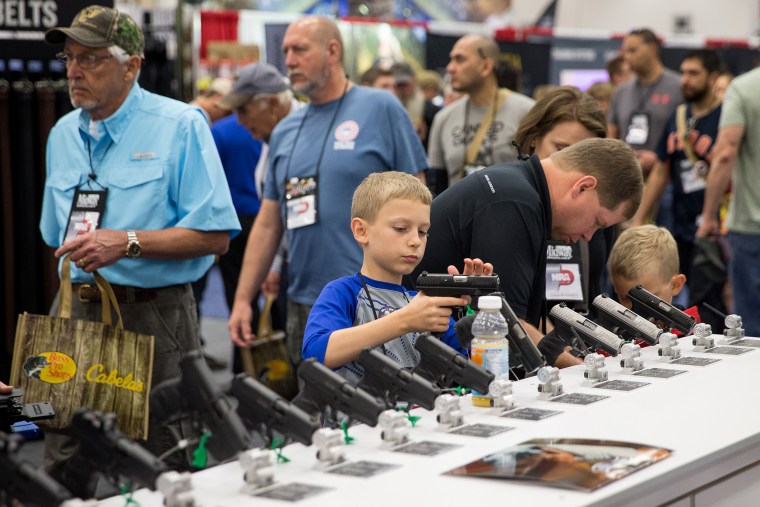If you think that your young child knows what to do when they come across a gun, research shows you’re wrong. Children are just as likely to handle a gun while unsupervised even after having undergone gun safety education.
The American Academy of Pediatrics estimates that firearms are one of the top three causes of death among U.S. children and, on average from 2012 to 2014, nearly 1,300 children died each year in the United States from a firearm-related injury. But 6 percent of these were accidental and therefore preventable; about half of the accidents took place in the child’s home, while one-third occurred at the house of a friend or a relative.
However, when guns are so common in the U.S. that there are more guns than people — civilians have more than 350 million firearms — not having guns in children’s homes (or those they visit) isn’t realistic even if it is the most effective way to prevent firearm-related injuries and deaths.
Children are just as likely to handle a gun while unsupervised even after having undergone gun safety education.
Although we had no guns in our home, after a young man fatally shot 20 first-graders and six teachers and staffers at the Sandy Hook Elementary School in Sandy Hook, Connecticut, (where I live), I wondered what my then-kindergarten-aged daughter might do if she came across a firearm and what programs existed to teach children about gun safety.
What I found amazed me: 72 percent of parents believe their children can tell a real gun from a fake one (although it is not developmentally possible for young children to tell a real gun from a toy gun); and 85 percent of parents reported they did not practice safe gun storage.
Parents want their children to be safe. Some parents may choose to live in a gun-free home — but not all parents do so, with approximately one-third of U.S. homes with children having guns present according to the American Academy of Pediatrics. These guns are not always stored safely: Almost two million children live in a home with guns that are unlocked and loaded. These guns can be used by a child to unintentionally injure or kill themselves or someone else and, in 2017, at least 285 children in the U.S. unintentionally shot themselves or another person.
There are really no existing firearm safety programs that work well outside of the teaching situation.
That’s why all children need to know how to be safe around guns, especially in the United States, which has highest relative accessibility of guns among developed countries. There are really no existing firearm safety programs that work well outside of the teaching situation.
The Eddie the Eagle program is most widely recognized; it tries to teach children what to do if they find an unsupervised gun. Other approaches providing children with information about the dangers of guns or allowing them to handle a gun while supervised. But overall these gun safety education efforts do not appear to reduce the likelihood that children will not handle firearms when firearms are present in an unsupervised situation.
Increasing a child’s knowledge about what to do if he or she comes across an unsupervised gun makes sense, but it provides no certainty they will translate this knowledge to a real-life situation. Research bears this out.
Evidence shows that gun safety education for children 4–9 years of age doesn’t “stick” and evidence for what works in gun safety education with older children is not available.
My colleagues and I at Rutgers University recently published a study in “Health Promotion Practice” that reviewed research on gun safety education programs. Several tactics are used to teach children about gun safety: The "just say no" strategy instructs children to tell an authority figure when they find a gun; the active, skills-based strategy teaches children how to resist the temptation of touching a gun; and the most commonly used method is passive learning, in which children watch videos or read printed materials to learn about gun safety.
We found that none of these programs work well. None of these strategies are effective over time with young children: Evidence shows that gun safety education for children 4–9 years of age doesn’t “stick” and evidence for what works in gun safety education with older children is not available. While children can recite gun safety rules, the majority did not follow these rules when they were exposed to prop guns.
The studies conducted were focused on children aged 4-9 years; there are few studies of programs that involve adolescents and teens. Given the national Youth Risk Behavior Surveillance System reports that 13,263 of high school respondents reported carrying a gun at least once during the 30 days before the survey, and more than 15,468 reported carrying a gun on school property, the lack of research on this population was surprising.
Relying on your children to know they shouldn’t touch what you’ve told them not to touch isn’t a good way to keep their hands out of a cookie jar, let alone a gun safe
The pressing issue, then, is not gun control but how to keep our children safe around the guns they will almost certainly encounter. Until we determine more effective ways to teach children to adhere to gun safety, the two best solutions are to not have guns in the house, or to ensure they are locked away and the key or code cannot be found. Hiding a gun under the sofa or in the closet is dangerous, and relying on your children to know they shouldn’t touch what you’ve told them not to touch isn’t a good way to keep their hands out of a cookie jar, let alone a gun safe.
The guns in Sandy Hook killer’s house, for instance, were in a gun safe. It was unlocked.
Cheryl Holly is a professor and co-director of the Northeast Institute for Evidence Synthesis and Translation at Rutgers University School of Nursing.

